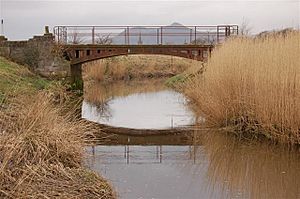Black Devon facts for kids

The Black Devon is a river in Scotland. It starts in the Cleish Hills, in an area called Outh Muir. This is about 1.5 kilometres (1 mile) north of Knockhill Racing Circuit and 9 kilometres (5.6 miles) north-west of Dunfermline in Fife. Three small streams join together there to form the river.
The Black Devon flows west through Balgonar and north of Saline, where it joins the Saline Burn. It then enters Clackmannanshire, passing through the small village of Forestmill and the town of Clackmannan. Finally, the Black Devon flows into the River Forth south of Alloa, about 1 kilometre (0.6 miles) north of Dunmore Pier.
This river is quite narrow and shallow. You can find wild brown trout living here. In the winter, sea trout also swim into the river from the Firth of Forth. The Rivers and Fisheries Trusts of Scotland help look after the River Forth and its smaller rivers, including the Black Devon. Other rivers they manage are the River Devon, River Teith, and River Allan.
Contents
Where Did the River Go?
In June 1952, something unusual happened to the Black Devon. The last 3 kilometres (2 miles) of the river seemed to disappear! It turned out the water had flowed into old coal mine tunnels underground. These tunnels eventually filled up with a mix of fresh and salty water, because the river was close to the sea where the tide comes in.
Helping Nature: The Wetland Project
For a very long time, people dug for coal near the Black Devon. This caused the ground to sink a lot, especially where the Black Devon meets the River Forth. People also worried about sea levels rising.
The land between the Black Devon and the Forth had sunk quite a bit. It used to be used for dumping rubbish, but this had to stop because of new rules about protecting the environment. So, a plan was made to create a special wetland area. This helps nature and manages the water better.
Gartmorn Dam: An Old Reservoir
Gartmorn Dam is a large reservoir that was built a long time ago, in 1712. It was designed by George Sorocold for John Erskine, Earl of Mar. The dam's main job was to provide water power for pumps. These pumps were used to drain water from the Earl's coal mines in Alloa.
Gartmorn Dam isn't directly on the Black Devon river. Instead, it gets its water from the Black Devon through a special channel called a lade. This lade starts at a small wall, called a weir, in the Black Devon just above Forestmill.
Today, Gartmorn Dam is a popular place for fun activities like walking and fishing. The weir and the lade are still in good condition. In 2013, Scottish Water spent £440,000 to keep the dam's main wall strong and improve how they can lower the water level in emergencies.
Other Old Industries
Old maps from 1956 show that there were other businesses along the Black Devon. There were weirs and a place called Linn Mill, and you can still find parts of it today. Further downstream, there was once a Woollen Mill, which used water power from the river. This mill is now covered by houses. We don't know how much other quarries and mines along the river used water power.

